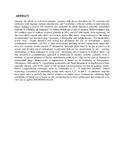| dc.contributor.author | Rogo, O. Michael | |
| dc.contributor.author | Oyim, James, | |
| dc.contributor.author | Manyim, S, | |
| dc.contributor.author | Ndakala, A lbert | |
| dc.contributor.author | Derese, Solomon | |
| dc.date.accessioned | 2015-11-05T09:42:11Z | |
| dc.date.available | 2015-11-05T09:42:11Z | |
| dc.date.issued | 2015 | |
| dc.identifier.citation | Rogo O. Michael , Oyim James, Manyim S, Ndakala A lbert and Derese Solomon (2015). Antimalarial drug discovery through in silico scaffold hopping using a database of natural products of Kenya. The 16th symposium of the natural products reseach network for eastern and central Africa (NAPRECA) 31st August to 3rd September 2015, pp.50. Arusha, Tanzania | en_US |
| dc.identifier.uri | http://www.napreca-tz.org/16napreca/16th_NAPRECA_Book_Abstracts.pdf | |
| dc.identifier.uri | http://hdl.handle.net/11295/92280 | |
| dc.description.abstract | Despite the efforts to 'roll back malaria', statistics still shows that there are 97 countries and
territories with ongoing malaria transmission, and 7 countries i
n the prevention or reintroduction
phase, making a total of 104 countries and territories in which malaria is presently considered
endemic 4. Globally, an estimated 3.4 billion people are at risk of malaria. WHO estimates that
207 million cases of malaria
occurred globally in 2012 and 627 000 deaths were registered. Of the
cases (80%) and de
aths (90%) occurred in Africa.
The multi
-
drug resistance to the widely recommended and provided drug treatments (Chloroquine
and Sulphadoxine
-
Pyrimethamine) across Asia
, South America and Africa has prompted the use of
Artemisinin
-
based combination treatments (ACTS) 1. This necessitates profiling of new
antimalarial drugs that have low resistant strains towards P. falciparum. Strategic plans need to be
put in place to di
scover and develop novel antimalarial compounds that are not encumbered by
pre
-
existing mechanisms of drug resistance to avoid ever
-
increasing toll of malaria on tropical
areas 2 In this research, a computational approach is employed to identify suitable
scaffolds form a
database of natural products of Kenya (mitishamba.uonbi.ac.ke ) that can be used as alternative
antimalarial drugs. Benzoxazine (Cappamensin A based on its similarity to Primaquine),
Chromones (Abyssinone V, a promising compound) and Naph
thoquinone (Lapachol) have been
carefully chosen; with IC50 values of the isolated natural products serving as guiding values.
Heavy computational techniques such as Generation of 3
-
D molecular database, Virtual Screening,
Calculation of probability assign
ment curves 3, 2
-
D and 3
-
D similarity searches have been used to
identify the natural products of prime focus. Compounds exhibiting high probability of being
active based on the calculations have been synthesized and subjected to in vitro ass
ay against
PfD
HODH enzyme | en_US |
| dc.language.iso | en | en_US |
| dc.publisher | University of Nairobi | en_US |
| dc.title | Antimalarial drug discovery through in silico scaffold hopping using a database of natural products of Kenya | en_US |
| dc.type | Presentation | en_US |
| dc.type.material | en | en_US |

